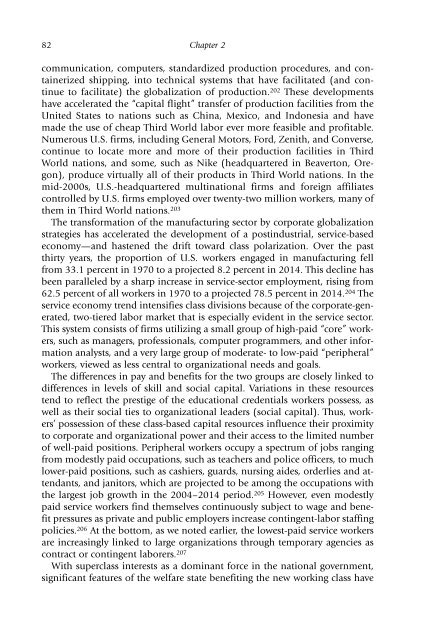Separate Realities: The Dream and the Iceberg - Scarecrow Press
Separate Realities: The Dream and the Iceberg - Scarecrow Press
Separate Realities: The Dream and the Iceberg - Scarecrow Press
Create successful ePaper yourself
Turn your PDF publications into a flip-book with our unique Google optimized e-Paper software.
82 Chapter 2<br />
communication, computers, st<strong>and</strong>ardized production procedures, <strong>and</strong> containerized<br />
shipping, into technical systems that have facilitated (<strong>and</strong> continue<br />
to facilitate) <strong>the</strong> globalization of production. 202 <strong>The</strong>se developments<br />
have accelerated <strong>the</strong> “capital flight” transfer of production facilities from <strong>the</strong><br />
United States to nations such as China, Mexico, <strong>and</strong> Indonesia <strong>and</strong> have<br />
made <strong>the</strong> use of cheap Third World labor ever more feasible <strong>and</strong> profitable.<br />
Numerous U.S. firms, including General Motors, Ford, Zenith, <strong>and</strong> Converse,<br />
continue to locate more <strong>and</strong> more of <strong>the</strong>ir production facilities in Third<br />
World nations, <strong>and</strong> some, such as Nike (headquartered in Beaverton, Oregon),<br />
produce virtually all of <strong>the</strong>ir products in Third World nations. In <strong>the</strong><br />
mid-2000s, U.S.-headquartered multinational firms <strong>and</strong> foreign affiliates<br />
controlled by U.S. firms employed over twenty-two million workers, many of<br />
<strong>the</strong>m in Third World nations. 203<br />
<strong>The</strong> transformation of <strong>the</strong> manufacturing sector by corporate globalization<br />
strategies has accelerated <strong>the</strong> development of a postindustrial, service-based<br />
economy—<strong>and</strong> hastened <strong>the</strong> drift toward class polarization. Over <strong>the</strong> past<br />
thirty years, <strong>the</strong> proportion of U.S. workers engaged in manufacturing fell<br />
from 33.1 percent in 1970 to a projected 8.2 percent in 2014. This decline has<br />
been paralleled by a sharp increase in service-sector employment, rising from<br />
62.5 percent of all workers in 1970 to a projected 78.5 percent in 2014. 204 <strong>The</strong><br />
service economy trend intensifies class divisions because of <strong>the</strong> corporate-generated,<br />
two-tiered labor market that is especially evident in <strong>the</strong> service sector.<br />
This system consists of firms utilizing a small group of high-paid “core” workers,<br />
such as managers, professionals, computer programmers, <strong>and</strong> o<strong>the</strong>r information<br />
analysts, <strong>and</strong> a very large group of moderate- to low-paid “peripheral”<br />
workers, viewed as less central to organizational needs <strong>and</strong> goals.<br />
<strong>The</strong> differences in pay <strong>and</strong> benefits for <strong>the</strong> two groups are closely linked to<br />
differences in levels of skill <strong>and</strong> social capital. Variations in <strong>the</strong>se resources<br />
tend to reflect <strong>the</strong> prestige of <strong>the</strong> educational credentials workers possess, as<br />
well as <strong>the</strong>ir social ties to organizational leaders (social capital). Thus, workers’<br />
possession of <strong>the</strong>se class-based capital resources influence <strong>the</strong>ir proximity<br />
to corporate <strong>and</strong> organizational power <strong>and</strong> <strong>the</strong>ir access to <strong>the</strong> limited number<br />
of well-paid positions. Peripheral workers occupy a spectrum of jobs ranging<br />
from modestly paid occupations, such as teachers <strong>and</strong> police officers, to much<br />
lower-paid positions, such as cashiers, guards, nursing aides, orderlies <strong>and</strong> attendants,<br />
<strong>and</strong> janitors, which are projected to be among <strong>the</strong> occupations with<br />
<strong>the</strong> largest job growth in <strong>the</strong> 2004–2014 period. 205 However, even modestly<br />
paid service workers find <strong>the</strong>mselves continuously subject to wage <strong>and</strong> benefit<br />
pressures as private <strong>and</strong> public employers increase contingent-labor staffing<br />
policies. 206 At <strong>the</strong> bottom, as we noted earlier, <strong>the</strong> lowest-paid service workers<br />
are increasingly linked to large organizations through temporary agencies as<br />
contract or contingent laborers. 207<br />
With superclass interests as a dominant force in <strong>the</strong> national government,<br />
significant features of <strong>the</strong> welfare state benefiting <strong>the</strong> new working class have
















